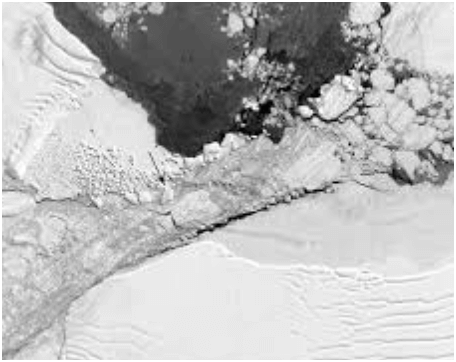Cryosphere, encompassing Earth’s frozen water reserves—ice sheets, glaciers, sea ice, snow cover, and permafrost—is undergoing dramatic transformation due to accelerating global warming.
Scientists are raising alarms about the rapid depletion of this critical component of the planet’s climate system, urging immediate and decisive action to mitigate the rate of ice and snow loss. The cryosphere is not only a fundamental driver of global climate regulation but also serves as a direct source of fresh water and a stabilizing force in ecological and economic systems. The continued decline of ice and snow due to rising global temperatures has far-reaching implications, impacting billions of lives and threatening the resilience of economies worldwide.
At the core of the cryosphere crisis is the sharp increase in global temperatures, which is accelerating the melting of ice at unprecedented rates. This process has been particularly visible in regions like the Arctic, Greenland, and Antarctica, where ice loss has reached levels that were, until recently, unforeseen. Recent studies indicate that Arctic sea ice, for instance, is melting faster than at any other time in recorded history, with summer ice coverage shrinking each year.
The warming of the polar regions is also causing permafrost—permanently frozen ground—to thaw, releasing vast amounts of stored greenhouse gases like carbon dioxide and methane into the atmosphere. This, in turn, creates a feedback loop, as these emissions further exacerbate global warming, accelerating the cryosphere’s decline and heightening the climate crisis.
The consequences of cryosphere loss extend far beyond the polar regions, affecting global weather patterns, sea levels, and biodiversity. As ice melts and snow cover decreases, the Earth’s albedo—or its ability to reflect sunlight—diminishes. Darker ocean and land surfaces, once exposed, absorb more heat, intensifying the warming effect. This warming contributes to erratic and extreme weather events around the world, including prolonged heatwaves, intense storms, and unpredictable precipitation patterns.
The impacts on weather are already felt in many regions, leading to crop failures, food insecurity, and increased strain on water resources. Melting glaciers and ice sheets are also contributing to rising sea levels, putting low-lying coastal areas at increased risk of flooding. Scientists estimate that even a modest rise in global temperatures could lead to a sea-level increase that would displace millions of people, especially in vulnerable island nations and coastal megacities.
Beyond environmental impacts, the cryosphere crisis poses a severe threat to the global economy. Sectors like agriculture, fisheries, tourism, and real estate face increased risks as climate patterns shift, ice melts, and sea levels rise. In regions dependent on seasonal snowfall and glaciers for freshwater, such as South Asia, melting glaciers endanger water supplies for both drinking and agriculture. The Indus, Ganges, and Brahmaputra river basins, which sustain hundreds of millions of people, rely on glacial meltwater.
As glaciers recede, these rivers are experiencing altered flow patterns, leading to seasonal water scarcity and affecting food production, rural livelihoods, and even national economies. Similarly, fisheries in polar regions and beyond are being disrupted as ocean temperatures rise and ecosystems shift. Species that thrive in cold, nutrient-rich waters are under stress, impacting both biodiversity and the livelihoods of communities dependent on marine resources.
Tourism is another industry vulnerable to the cryosphere crisis. Regions known for their winter sports, such as the Alps, Rockies, and the Himalayas, are seeing shorter snow seasons, reducing the viability of ski resorts and related businesses. This decline in winter tourism not only affects local economies but also creates challenges for entire regions whose revenue streams are tied to seasonal visitors. Glacial tourism, a key attraction in countries like Iceland, Norway, and New Zealand, is also at risk as glaciers continue to recede. Without intervention, these regions may lose a vital source of income and cultural heritage, further straining their economies and reducing opportunities for sustainable development.
Despite the urgent need for action, addressing the cryosphere crisis requires a coordinated global effort. Reducing greenhouse gas emissions is the most direct way to slow the rate of ice and snow loss. International agreements like the Paris Agreement aim to limit global warming to well below 2°C above pre-industrial levels, but current trajectories suggest that more robust measures are needed to prevent catastrophic warming. Transitioning to renewable energy sources, enhancing energy efficiency, and protecting natural carbon sinks like forests are crucial strategies for reducing emissions. Many scientists argue that urgent and large-scale investment in these areas is essential to preserve the cryosphere and stabilize the climate.
Innovative technologies and adaptation strategies are also necessary to mitigate the impact of ice loss. For instance, some researchers are exploring geoengineering solutions, such as artificially increasing ice reflectivity or slowing glacier melt through seawater barriers. However, these approaches are complex and carry risks, making them supplementary to, rather than replacements for, emissions reductions. Communities facing imminent threats from rising sea levels and altered water supplies are adopting adaptation measures, such as building sea walls, relocating to higher ground, and implementing advanced water conservation techniques. While these solutions may provide temporary relief, they are ultimately unsustainable without global efforts to curb the root causes of climate change.
Public awareness and governmental action are essential in addressing the cryosphere crisis. Policymakers are being urged to recognize the critical role that the cryosphere plays in global stability and to prioritize actions that protect ice and snow resources. Citizens can also contribute by reducing their carbon footprint, supporting policies aimed at climate resilience, and advocating for environmental protections. The cryosphere crisis is a reminder of the interconnected nature of Earth’s systems and the global implications of environmental degradation.
Inaction on the cryosphere crisis could have devastating effects, potentially leading to a tipping point from which recovery is nearly impossible. The loss of ice and snow is not merely a distant issue confined to the polar regions; it is a crisis that will have cascading impacts on every continent and economy. By taking immediate, concerted action, humanity can slow the cryosphere’s decline, protect vulnerable populations, and preserve a stable and habitable planet for future generations.
